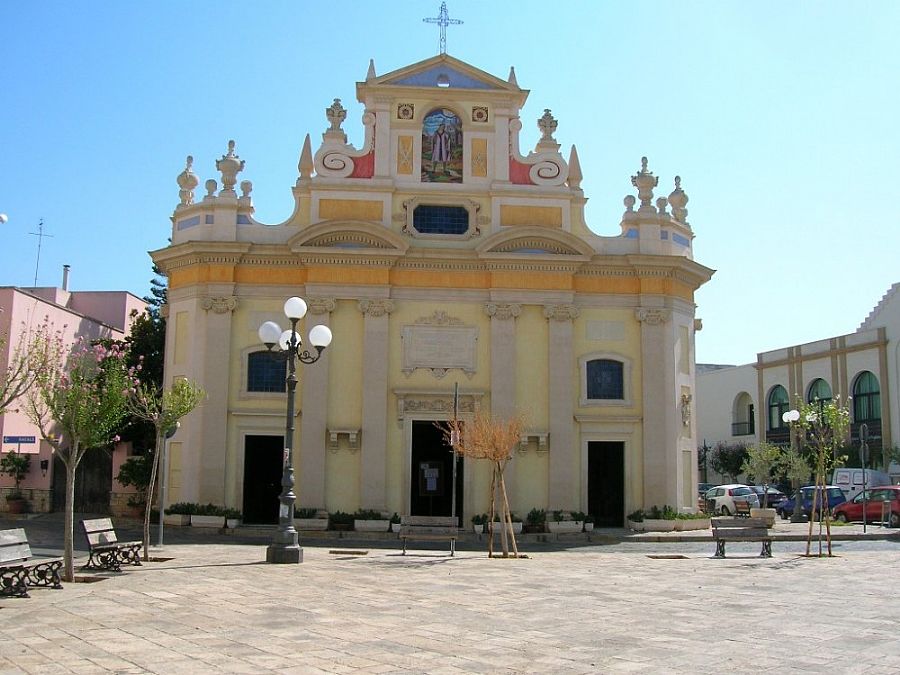Taviano

Situated in Puglia's sun-drenched Salento, Taviano is a town of 12,300 people near Gallipoli. It is called "la citta' dei fiori" (city of flowers) for the vast cultivation of blooms that are then sold all over the country. With the most fertile fields in the province, it also produces a variety of vegetables, along with fruit orchards, olive groves and wine grapes.
Located next to Racale and Melissano, Taviano's territory also encompasses the seaside Marina di Mancaversa, just a few minutes away on the Ionian Sea. It is also just 50 kilometers to Lecce.The town offers many shops and restaurants, more than you'd think for its size. Tucked within the old town are narrow lanes that are fun to explore and find hidden gems, pretty details and eateries tucked away.
Ancient Origins
Taviano was originally settled by settlers from Crete who came to their Magna Grecia colony in Puglia. Then the Romans arrived but it didn't thrive or develop as a true town until the Norman period, when the King Tancredi gave it as a feudal territory in 1180, and a Basilian monastery was established . It remained a feudal land for centuries, passing from one wealthy lord to another, ending with the Caracciolo family, until the abolition of feudalism.
The Town
Many of the buildings in the old town were built in typical Pugliese fashion with low white-washed sugar cube-like pattern, though there are also palaces of two or stories with Baroque embellishments, the region's favored style, and decked with ornate iron balconies. The old town radiates off from the Piazza San Martino, where the main church is located, dedicated to the city's patron saint. The church is understated Baroque, built in 1635. Inside are paintings from that period and later. Stop for a cappuccino or drink at the Antica Caffetteria there in the piazza and then wander the old town to enjoy the atmosphere. On Piazza del Popolo you'll find the town hall, along with Palazzo Marchesale de Franchis, the baron's palace that was home to the feudal lords. It now hosts events and exhibitions.
Outside town is the rock church ("chiesa rupestre") of Santa Marina, with well-kept frescoes that have been recently restored. Closer to the sea is the fantastical Castelforte, a strange but delightful castle with arched windows, turrets, spires and peaks. It is set in an ancient olive grove and enjoys views of the sea; it's home to a center for seniors and disadvantaged youth, but is worth gazing at its odd architecture! Scattered around the countryside here are testaments of the antiquity of Puglia going back to neolithic times - there are megalithic dolmens and menhir around.
You'll also see the fields of orchards and vegetable cultivation, and wholesale markets for the products. Olive oil can be purchased direct from the growers, as can Salento wine. This location lets you taste the best of both side of Puglia's cuisine, the inland "land-based" dishes as well as the delectable seafood specialties!
Browse carefully selected vacation home rentals in Taviano.

 Amalfi Coast
Amalfi Coast Sorrento Coast
Sorrento Coast Tuscany
Tuscany Cilento National Park
Cilento National Park Lake Como
Lake Como Rome and Latium
Rome and Latium Umbria
Umbria Capri and Ischia
Capri and Ischia Venice
Venice Puglia (Apulia)
Puglia (Apulia) Liguria
Liguria Sicily
Sicily Lake Maggiore
Lake Maggiore Lombardy
Lombardy Sardinia
Sardinia Lake Garda
Lake Garda Abruzzo and Marche
Abruzzo and Marche Calabria
Calabria

